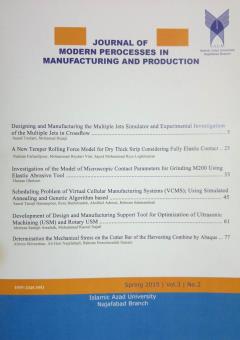Evaluation of Integrated Artificial Intelligence and Computational Fluid Dynamics for Advanced Drilling Fluid Formulation
الموضوعات :Fardin Talebi 1 , Yousef Shiri 2
1 - Shahrood University of Technology, Faculty of Mining, Petroleum and Geophysics Engineering, Shahrood, Iran
2 - 1Shahrood University of Technology, Faculty of Mining, Petroleum and Geophysics Engineering, Shahrood, Iran
الکلمات المفتاحية: Artificial Intelligence, drilling, design,
ملخص المقالة :
Drilling fluids are essential for efficient drilling operations, with gelation performance playing a crucial role in maintaining wellbore stability, transporting cuttings, and preventing losses. This review examines the transformative potential of artificial intelligence (AI) and numerical simulation in enhancing the optimization of drilling fluid gel performance and formulation design. Four AI techniques—expert systems, artificial neural networks (ANNs), support vector machines (SVMs), and genetic algorithms—are evaluated, with ANNs dominating 52% of studies due to their ability to model nonlinear relationships. Numerical simulation methods, including computational fluid dynamics (CFD), molecular dynamics (MD), and Monte Carlo simulations, are analyzed for their capacity to simulate fluid behavior under complex conditions. Key challenges include limited access to field data and oversimplified model assumptions, which hinder predictive accuracy. Circulation loss, a primary concern in over 17% of research, underscores the need for robust predictive models. The review proposes three future directions: enhancing interpretable AI through feature engineering, establishing open-access oil and gas databases, and advancing microscopic numerical simulations to reduce data dependency. By integrating AI with numerical methods, researchers can better address high-dimensional, nonlinear problems in drilling fluid design. This synergy promises cost-effective, precise formulation optimization, paving the way for intelligent drilling technologies. The findings underscore the need for hybrid approaches and data accessibility to address current limitations and drive innovation in the drilling fluid industry, ultimately enhancing operational efficiency and environmental sustainability.
[1] Yang, J., Jiang, G., Huang, S., Yi, J., Dong, T., He, Y., Yang, L., Feng, Q. and Wang, G. 2024. Nanobiocatalyst Based on Enzyme Immobilization for Mudcake Removal and Reservoir Damage Control. Energy & Fuels. 38(16): 15194–203. doi: 10.1021/acs.energyfuels.4c02514.
[2] He, Y., Du, M., He, J., Liu, H., Lv, Y., Guo, L., Zhang, P. and Bai, Y. 2023. An Amphiphilic Multiblock Polymer as a High-Temperature Gelling Agent for Oil-Based Drilling Fluids and Its Mechanism of Action. Gels. 9(12): 966. doi: 10.3390/gels9120966.
[3] Wang, Q., Slaný, M., Gu, X., Miao, Z., Du, W., Zhang, J. and Gang, C. 2022. Lubricity and rheological properties of highly dispersed graphite in clay-water-based drilling fluids. Materials. 15(3): 1083. doi: 10.3390/ma15031083.
[4] Agwu, O.E., Akpabio, J.U., Alabi, S.B. and Dosunmu, A. 2018. Artificial intelligence techniques and their applications in drilling fluid engineering: A review. Journal of Petroleum Science and Engineering. 167: 300–15. doi: 10.1016/j.petrol.2018.04.019.
[5] Sheng, K., He, Y., Du, M. and Jiang, G. 2024. The Application Potential of Artificial Intelligence and Numerical Simulation in the Research and Formulation Design of Drilling Fluid Gel Performance. Gels. 10(6): 403. doi: 10.3390/gels10060403.
[6] Agwu, O.E., Akpabio, J.U., Alabi, S.B. and Dosunmu, A. 2018. Artificial intelligence techniques and their applications in drilling fluid engineering: A review. Journal of Petroleum Science and Engineering. 167: 300–15. doi: 10.1016/j.petrol.2018.04.019.
[7] Sheng, K., He, Y., Du, M. and Jiang, G. 2024. The Application Potential of Artificial Intelligence and Numerical Simulation in the Research and Formulation Design of Drilling Fluid Gel Performance. Gels. 10(6): 403. doi: 10.3390/gels10060403.
[8] Agwu, O.E., Akpabio, J.U., Alabi, S.B. and Dosunmu, A. 2018. Artificial intelligence techniques and their applications in drilling fluid engineering: A review. Journal of Petroleum Science and Engineering. 167: 300–15. doi: 10.1016/j.petrol.2018.04.019.
[9] Ni, X., Liu, Z. and Wei, J. 2019. Quantitative evaluation of the impacts of drilling mud on the damage degree to the permeability of fractures at different scales in coal reservoirs. Fuel. 236: 382–393. doi: 10.1016/j.fuel.2018.08.130.
[10] Andrade, G. M. P., Oechsler, B. F., Coelho, J. S. C., Fagundes, F. M., Arouca, F. O., Damasceno, J. J. R., Scheid, C. M. and Calçada, L. A. 2021. Evaluation of characteristic diameter on barite settling in drilling fluids by Monte Carlo method. Journal of Petroleum Science and Engineering. 206: 109072. doi: 10.1016/j.petrol.2021.109072.
[11] Albattat, R., Hoteit, H. and Sun, S. 2022. Modeling lost-circulation in natural fractures using semi-analytical and numerical approaches. Journal of Petroleum Science and Engineering. 214: 110770. doi: 10.1016/j.petrol.2022.110770.
[12] Malika, K., Boumya, W., Attarki, J., Mahsoune, A., Sadiq, M., Abdennouri, M., Kaya, S., and Barka, N. 2022. A combined DFT, Monte Carlo, and MD simulations of adsorption study of heavy metals on the carbon graphite (111) surface. Chemical Physics Impact. 5: 100121. doi: 10.1016/j.chphi.2022.100121.
[13] Kania, D., Yunus, R., Omar, R., Abdul Rashid, S., Mohamed Jan, B., & Aulia, A. 2021. Adsorption of non-ionic surfactants on organoclays in drilling fluid investigated by molecular descriptors and Monte Carlo random walk simulations. Applied Surface Science. 202: 148154. doi: 10.1016/j.apsusc.2020.148154.
[14] Hussain, I., Lamiel, C., Javed, M.S., Sahoo, S., Ahmed, M., Chen, X. and Zhang, K. 2022. Plant-and fungi-inspired hierarchical structures as electrode materials: a review. Materials Chemistry Frontiers. 6(23): 3460–88. doi: 10.1039/D2QM00826B.


